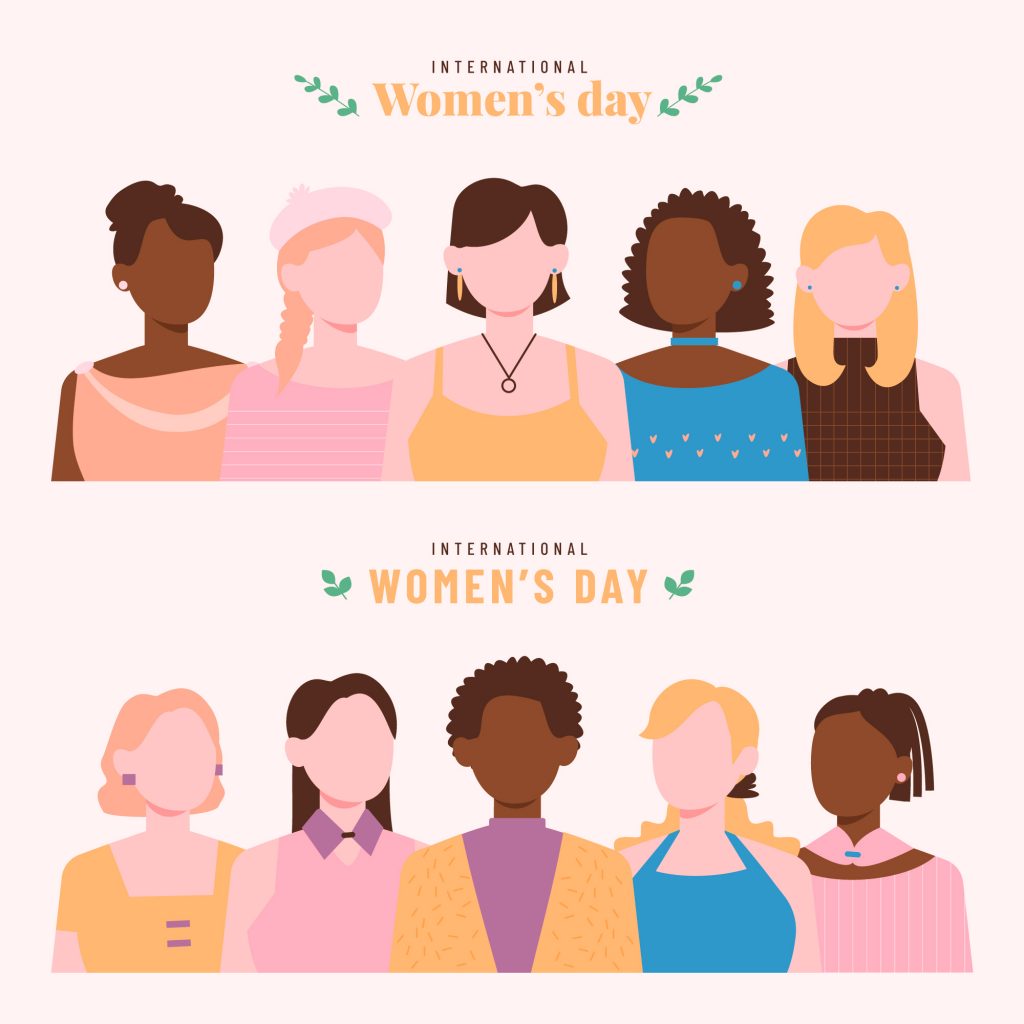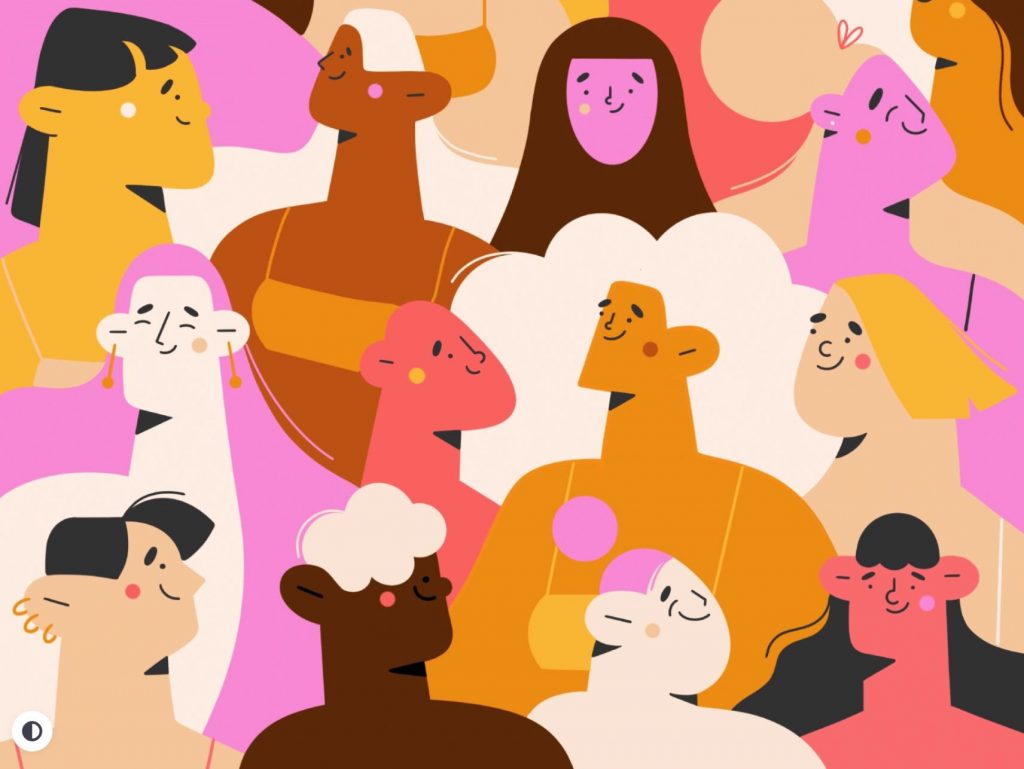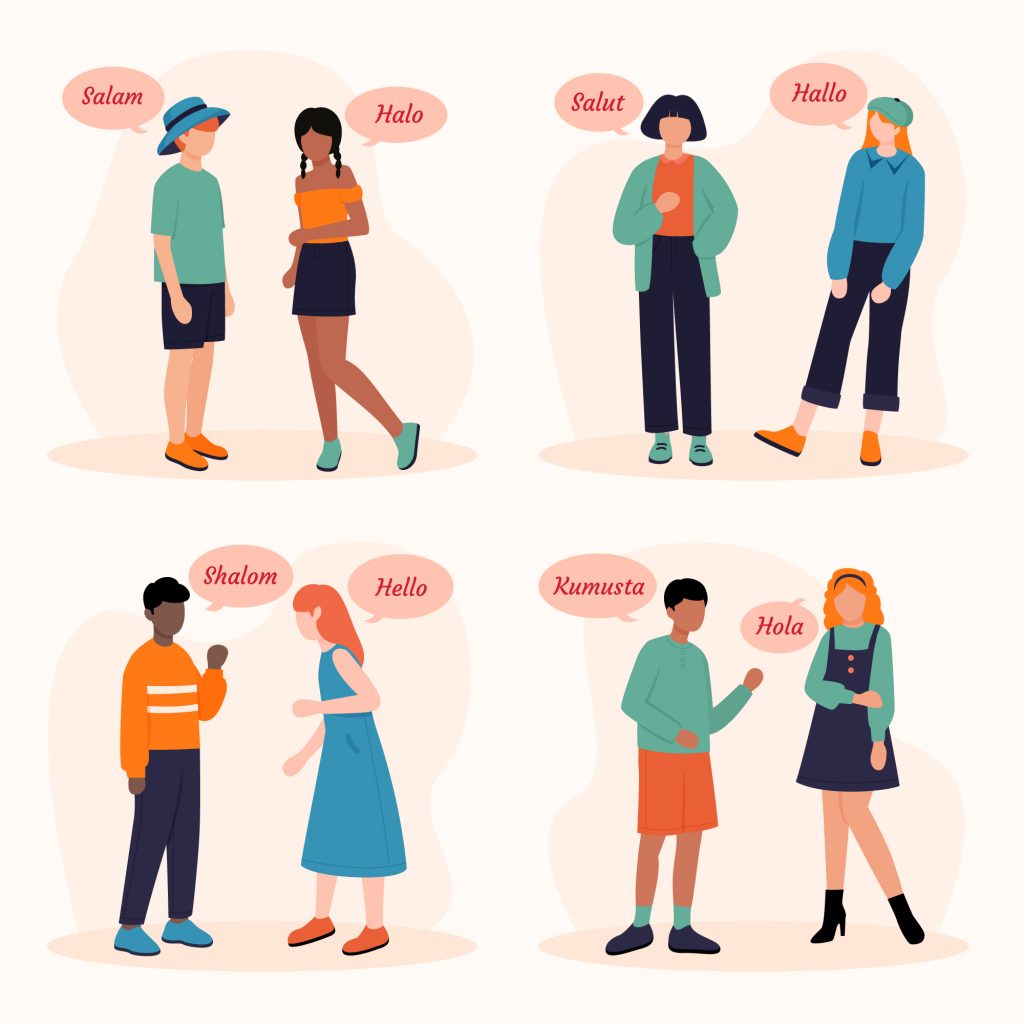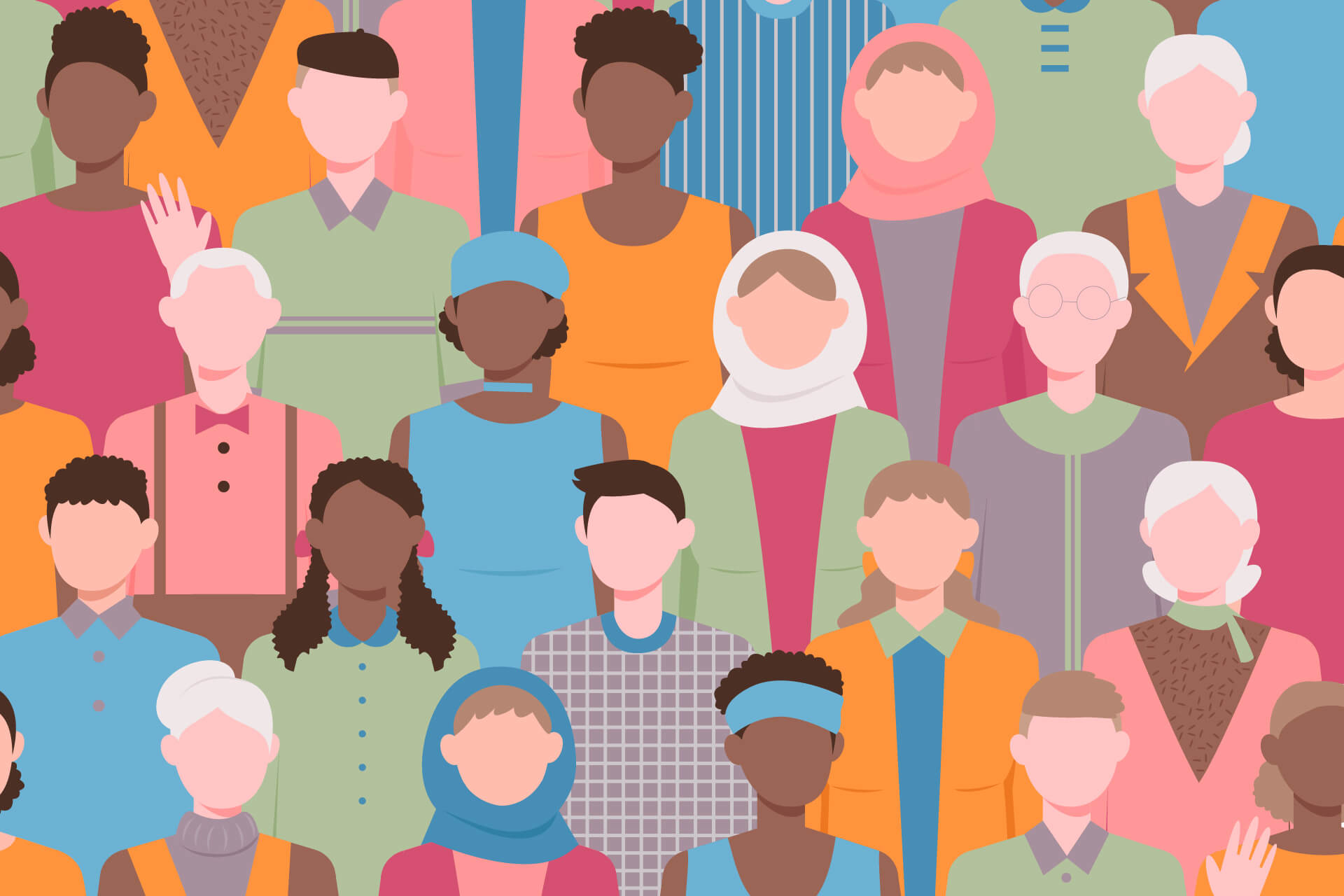Diversity and inclusion in design mean the focus on including various people from different backgrounds, abilities, and experiences to help create more useful and universal products or services. More and more organizations and businesses are getting familiar with this concept. As designers, our work is keeping our designs up-to-date and fitting the needs of the market.
In this article, you’ll learn 8 simple tactics to create inclusive designs, including the use of diverse illustrations, the care in using language, color, and other design elements.
The importance of diversity and inclusion in graphic design
Taking inclusion, diversity, and equity into account can help us, as designers, better express concerns and cares for all types of users, hence, increasing trust and loyalty. The more diverse our designs become, the broader audiences we can reach, and as a result, the better our products can be known and loved.
Designs that value, reflect, and incorporate all types of individuals help us move beyond pure business goals and objectives – to earn profits. They help brands and businesses communicate in a more human-centric and user-driven way.
Questions about diversity before designing?
Am I using diversity, equity, and inclusion correctly?
Diversity is about including all kinds of people. Race, ethnicity, gender identity, sexual orientation, socioeconomic level, language, culture, national origin, religion, age, ability, family structure, body type, and political perspective are a few examples of the many different types of diversity.
More than demographics, inclusion is about feeling like your belongings. Making sure that everyone, despite their differences feels that they are valued equally. To understand what people need and if they feel included, we must interact with the individuals we are designing for, from our team members to our audiences.
Offering equal opportunities is not what we mean when we say equity; rather, we suggest paying attention to the results of those opportunities. If we treat every individual equally, the systemic injustices we still experience will continue to exist. Recognizing that every individual has unique demands and life experiences is essential. To update or level the playing field for all, we must elevate those who face greater obstacles. Increasing accessibility for persons with various disabilities, whether they be situational (like a broken limb) or diagnostic, is part of this.
Who is being excluded or disempowered?
Have you ever thought of the ones who are left out and oppressed? Have you ever represented them, I mean their ideas, stories, and bodies in your inclusive designs? For example, are LGBTQ+ and BIPOC(Black, Indigenous, and People of Color) people represented at all? Or are you sure you are creating materials in all the languages your audiences prefer? Have you ever wondered how physically disabled or cognitive people will access and understand your inclusive designs?
It is crucial to be aware of how power dynamics are portrayed and even supported in your visual inclusive designs if you have a dominant social location in our culture (e.g., white, male, able-bodied, middle to upper class, etc.).
Have I considered my own biases and assumptions?
We as human beings always want to follow or take shortcuts, but unfortunately, these shortcuts in life can lead to major errors in perception and judgment. Cognitive preferences have profound social impacts, from racial profiling to political polarization. Stereotypes are frequently perpetuated through visual inclusive designs; therefore, we must be careful not to unintentionally or intentionally play into them.
Working with information does not guarantee our objectivity. What matters the most is how the information is framed or presented; we all are drawn to create the stories that best fit our preexisting beliefs. Stories are the most powerful as they convey emotions. The best information designs put details into context, and it is our responsibility to create stories that are not making any harm. Considering viewpoints quite different from ours helps us broaden our understanding; it can also help us share a complete story with our audiences.
What might be the possible impacts of my decisions for inclusive designs?
We may be able to change any individual’s safety, privacy, way of life, health, and relationships with the stories we tell through our informative inclusive designs. For example, we might explain laws or practices that disproportionately influence or impact specific communities without indicating that this is the case, or we might frame systemic damages in ways that make them appear to be individual mistakes.
We might be able to catch harm ourselves with our eyes, but even if we do, we have to face difficulties with denial or guilt. This is why inclusive designs are so not that important. By allowing others who are different from us to inform our thinking and process from the very beginning, we are more careful and concerned about what’s going forward. Like if someone thanks us by giving us the incredible gift of being able to learn from our mistakes, we have to do our best to repair and rearrange.
8 Tactics to embrace diversity and inclusion in graphic design
Practice self-awareness consistently
We can’t be able to change anything unless we are aware of our limitations. It doesn’t matter what we consciously think about ourselves because prejudices act subconsciously (a bias in and of itself). You can also take online implicit bias tests offered by Harvard to learn more about your individual biases.
What is more important is that we learn about ourselves, not to criticize nor rationalize, but to be more capable of spotting errors ourselves in our thinking and decision-making. The prejudices make it more difficult for us because so many of them keep us from having to challenge ourselves. That’s why we should consider it an ongoing practice, one that is more important than any of the others mentioned here in the list.
Learn from those who are different from you and acknowledge them
Our biases will also incline us to limit the people we connect with to those who are similar to us. It takes effort for us to communicate with the ones who are different from us, but making time to have these relationships is more likely to have the most powerful impact on our decision-making process.
To do so, we must appreciate the differences and understand that our diversity is our major strength. We will also learn how to ask for feedback, demonstrate we are listening, and do things differently because of what we have heard. It is essential to acknowledge them publicly, and if possible, we should also compensate them for their contributions to our work.
We should gather opinions as early as possible in the design process. If we delay, it might be harder to implement improvements (best case scenario), or people might suffer harm (worst case scenario).
Double-checking the data
How data is analyzed, collected, interpreted and shared can reinforce existing inequities or attempt to reverse them. Data can be utilized to violate someone’s personal privacy, exacerbate racial bias, or justify harmful decision-making.
If you are thinking of collecting data yourself, a lot of thoughts should be carefully considered, such as collector behavior, methodology, cultural translation, and much more. Data collection also includes power imbalance, with the researcher acting as an individual with control and the researcher as an individual being controlled.
If you ask someone their ethnicity, even something that could appear harmless, like this simple question, might cause dissatisfaction or even a little dispute.
If you are using information from a different source, look into the dataset and pay close attention to the details of how, where, and by whom the information was gathered. Find out if the data is open or closed before using it.
Public data is more accessible, verifiable or transparent, but depending on the source, context and purpose, it may be or may not be equitable.
Data that is not publicly available may raise special privacy issues and risks to people’s safety, such as reports about domestic violence or HIV status.
Data sharing should be legal, ethical, and, ideally, purposely linked to improving results for oppressed people because it can include significant privacy hazards. Both the impact of providing data and the impact of keeping data that could assist in the understanding or solution of an important issue can be disproportionately felt by some individuals.
Sharing information that sheds light on injustices can be quite effective. See the Actionable Intelligence for Social Policy toolkit from the University of Pennsylvania for more advice.
Once more, the sooner you can include individuals who will see things differently than you in a discussion about what data should be gathered or used, the better. Using data can be complex and confusing, so surround yourself with individuals who can advise you wisely.
Watch your language
Words and phrases like “Blacks,” “Hispanics,” “Latinx,” and even “People of Color” can be overly reductive and are deficit-based, such as “underrepresented,” “underserved,” “marginalized,” “minority,” and “non-white.” People who differ from what can be regarded as “normal” or dominant should not also be referred to as “diversity.”
As of this writing, “BIPOC” (Black, Indigenous, People of Color) or the real names of the nationalities, ethnicities, or other specific identities that the cited people themselves claim is defined by the communities mentioned. This style guide can help us learn more about capitalizing on each of these and “White.”
If you can, help your audience not only know better but also do better by giving them suggestions for what they can do to minimize inequalities and lift up liberation and justice in your inclusive designs.
Pay attention to the hierarchy
Designers use the technique of visual hierarchy to organize and structure all the elements so that viewers or their possible customers immediately n recognize each one’s importance. On the other side, social hierarchies are ways we implicitly or explicitly assess the significance of individuals. The former frequently unintentionally mirrors the latter.
You should always keep a close eye on whether specific persons or experiences are being promoted more than others. The most important or impacted people should be included in the data that shows demographics rather than the dominating group.
Be careful with color
When deciding the colors, there are numerous things to consider.
Like, at very first, you need to know whether the colors you are using are accessible for those with visual impairments or not. You have to avoid particular color collections like green and brown, red and green, blue and purple, green and brown, green and black, as they can be difficult to differentiate with color blindness.
Use inclusive imagery
Infographics are highly visual, so it is essential to use photos, diverse illustrations, and icons that help your audience connect with diverse experiences. Use inclusive designs that represent diverse identities, but not in a way that reinforces stereotypes. This includes people of different gender identities, abilities, gender identities, body types, etc. If you can, use gender-neutral icons with a variety of skin tones.
More importantly, try not to use symbols or reference cultures without understanding or knowing their meaning first. This is known as cultural appropriation, the unacknowledged or inappropriate adoption of aesthetics of oppressed people by dominant groups. If you want to define a culture that is not your own, you should ask for feedback from people in that culture, and if you cannot do that, you can also utilize inclusive designs or photographs.
Don’t forget other accessibility concerns
You will surely want to think about numerous more things to make your designs accessible to audiences with varying abilities. Like, we should use large sans-serif fonts and avoid patterned backgrounds and lengthy paragraphs of text. Think about what mediums you will share information through. Without an internet connection, web-based animations will be less accessible. On the other hand, long print publications might be costly for some individuals to purchase.
Conclusion
Inclusive designs are the process of making designs work accessible for and representable for as many audiences as possible. The word process is mentioned as inclusive designs are something that is constantly developing alongside technology and our learnings. Empathetic and humanistic, inclusive design forms the basis of any quality product or service. It shares an intense relationship with its opposite word, i.e., exclusion. Inclusive designs are about eliminating points of exclusion.
And, if you are looking for diverse illustrations, then illustAC is the best place you can go for. It has offered high-quality royalty stock illustrations and graphic images for the audience. Also, you can download the inclusive designs and diverse illustrations from illustAC in any file format like PNG or SVG, etc.













